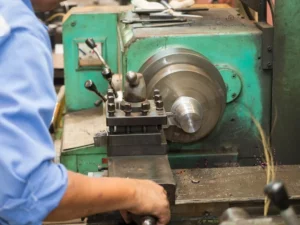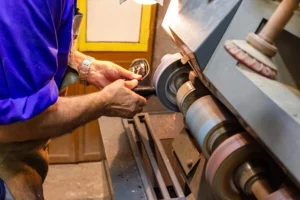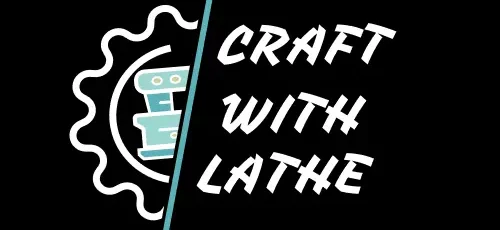In this comprehensive guide, we will take you through the step-by-step process of how to change belt on Delta Midi lathe. With this information, you can approach the task confidently and complete it efficiently.
Introduction Delta Midi Lathe
The Delta midi lathe is a versatile and reliable tool favoured by woodturning enthusiasts. Like any machine, it requires regular maintenance to maintain optimal performance. One important maintenance task is replacing the lathe belt, which may seem challenging at first but is quite simple once you understand the process. Regularly changing the belt helps keep the lathe running smoothly and efficiently.
How to change belt on Delta Midi Lathe – Easy Guide

Before diving into the step-by-step instructions, it’s essential to understand why changing the lathe belt is a pivotal aspect of the lathe. The lathe belt plays a vital part in transferring power from the motor to the spindle, enabling the lathe to rotate. Over time, wear and tear can degrade the belt, leading to a decline in performance. Regularly changing the belt not only ensures smooth operation but also extends the lifetime of your lathe.
Step 1: Safety First
Before you start any task, prioritise safety. Ensure that your lathe is turned off and open to avoid any accidents. It’s also a good idea to wear defensive gear, similar to safety spectacles and gloves, to guard yourself from indirect problems.
Step 2: Detect the Belt
The next step relates to the position of the lathe belt. In most Delta midi lathes, the belt is positioned on the pulleys that connect the motor to the spindle. Consult your lathe’s primer to pinpoint the exact position if you are doubtful.
Step 3: Loosen the Pressure
To make belt discarding easier, you will need to loosen the pressure. Numerous lathes have an attaching switch or clump that allows you to adjust the pressure on the belt. Loosen this medium until the belt is not tight.
Step 4: Remove the Old Belt
With the pressure released, precisely slide the old belt off the pulleys. Take note of the belt’s exposure, as you will need to reproduce this when installing the new bone.
Step 5: Opting for the right Relief Belt
Choosing the correct relief belt is pivotal for optimal performance. Relate to your lathe’s primer for the specific belt size and type recommended by the manufacturer. Using the wrong belt can lead to inefficiency and implicit damage to the lathe.
Step 6: Install the New Belt
Precisely slide the new belt onto the pulleys, making sure it follows the same path as the old one. Use the attaching switch or strain the belt until you achieve the recommended pressure. A properly released belt is essential for effective power transfer and prevents tripping during operation.
Step 7: Test the Lathe
Before putting the lathe back into regular use, perform a quick test to ensure everything is in working order. Turn on the lathe and observe the rotation to verify that the belt is properly aligned and performing easily.
Pros of How to Change Belt on Delta Midi Lathe

- Improved Performance: Changing the belt ensures optimal power transfer, leading to better performance and effectiveness of the lathe.
- Extended Lifespan: Regular conservation, including belt relief, contributes to the life of the lathe, reducing the threat of unanticipated breakdowns.
- Smooth Operation: A new belt reduces the chances of tripping, performs smoother and more controlled turning operations.
- Preventative conservation: Changing the belt is a visionary measure that helps address in implicit issues, saving time and plutocrat on expensive repairs in the long run.
- User Confidence: Knowing how to change the lathe belt promotes confidence in the user, empowering them to attack introductory conservation tasks singly.
Cons of How to Change Belt on Delta Midi Lathe
- Time-Consuming: Changing the belt can be time-consuming, especially for those unfamiliar with the process. It may bear some tolerance and practice.
- Implicit for Error: Improper installation of the new belt or applying the wrong pressure can lead to functional issues and, in extreme cases, damage to the lathe.
- Need for Tools: The process may require specific tools, and not everyone may have immediate access to them. This could be an implicit hurdle for some professionals.
- The threat of Injury: There’s a threat of injury if safety preventives aren’t followed. Professionals must be conservative and follow safety guidelines.
- Cost of relief: Belt. While not a significant con, losing a relief belt incurs a cost. Still, this cost is fairly minor compared to the implicit repairs performed from neglected conservation.
Conclusion
Changing the belt on your Delta midi lathe is an aspect of lathe conservation that can significantly impact performance and life. By following these step-by-step instructions, you can confidently take over this task, icing your lathe operates at its stylish for times to come. Regular conservation, including belt relief, is the key to unleashing the full potential of your woodworking trials with the Delta midi lathe.
FAQs
Why is it necessary to change the belt on a Delta midi lathe?
Changing the belt on a Delta midi lathe is necessary for several reasons. Over time, the lathe belt can wear out, leading to decreased performance and implicit slippage. Regular belt conservation ensures effective power transfer, smoother operation, and an extended lifetime for the lathe.
How frequently should I change the belt on my Delta midi lathe?
The frequency of belt changes depends on the operation and wear. As a general guideline, it’s recommended to check the belt regularly and replace it when signs of wear and tear, similar to cracks or rapping, become apparent. Also, including belt relief as part of routine lathe conservation can help unlooked-for issues.
What safety precautions should I take when changing the belt on my lathe?
Safety is paramount when working with the ministry. Before starting, ensure the lathe is turned off and unclogged. Wear applicable defensive gear, similar to safety spectacles and gloves, to guard against implicit hazards. Follow the manufacturer’s safety guidelines and refer to the lathe primer for specific safety recommendations during the belt-changing process.




